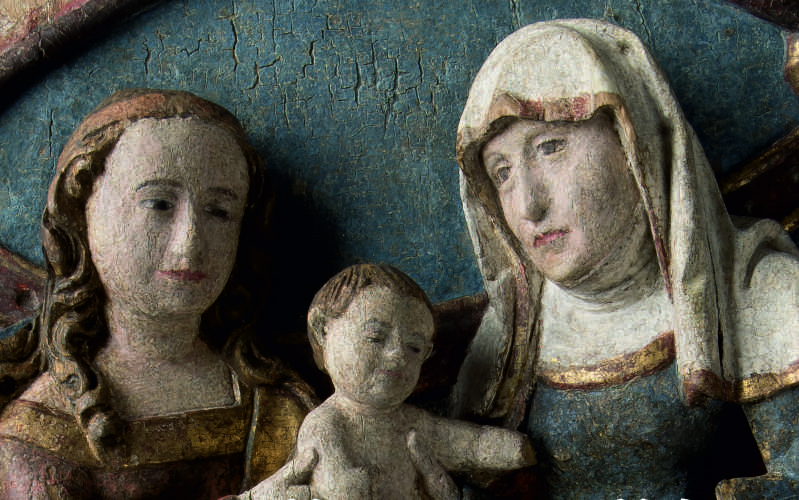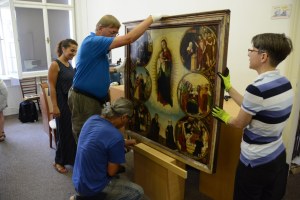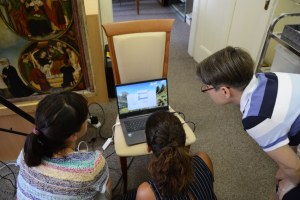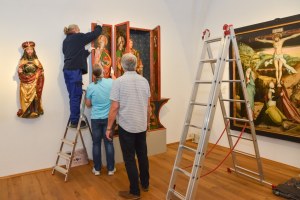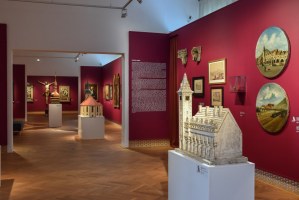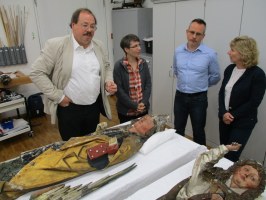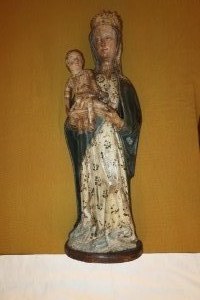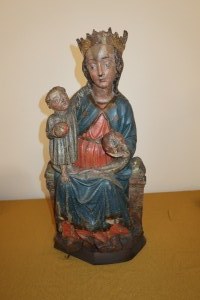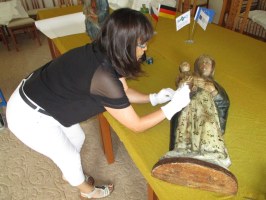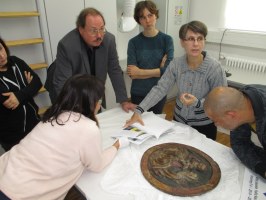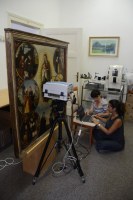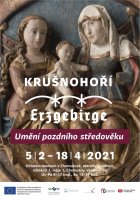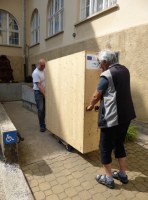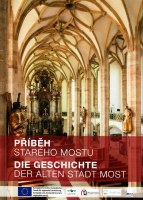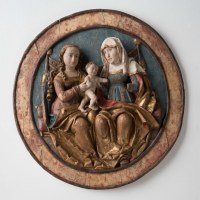The Art of the Late Middle Ages in the Mining Region of the Ore Mountains
› Detail › The Art of the Late Middle Ages in the Mining Region of the Ore Mountains
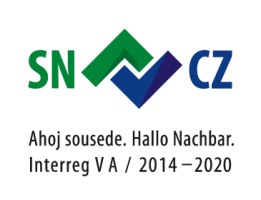
The Art of the Late Middle Ages in the Mining Region of the Ore Mountains
Information about the conclusion of the project (June 2021)
The Czech-German cross-border project The Art of the Late Middle Ages in the Mining Region of the Ore Mountains was completed on June 30, 2021, with the realization of individual planned activities. Meanwhile, the exhibition Ore Mountains / Erzgebirge – The Art of the Late Middle Ages at the Regional Museum in Chomutov closed at the end of May 2021, which is accessible through a virtual tour on the websites of the project partners during the sustainability period. They bid farewell with a joint final workshop held on June 24, 2021.
In April 2021, the Ústí Region published works from the Czech-German cross-border project The Art of the Late Middle Ages in the Mining Region of the Ore Mountains. There are a total of five volumes summarizing the results of the restoration of five artworks from the property of the Ústí Region presented at the exhibition ORE MOUNTAINS / ERZGEBIRGE - THE ART OF THE LATE MIDDLE AGES at the Regional Museum in Chomutov. The publications with the subtitle of the project were published in this order: Saint Anne Samotřetí (Volume 1), Votive Panel from Most by Master I.W. (Volume 2), Throne Madonna I. from the Most collection (Volume 3), Retable with St. Barbara from the Chomutov collection (Volume 4), and Madonna from Krupka II. (Volume 5). The collection items are managed by the Regional Museum in Chomutov, the Regional Museum and Gallery in Most, and the Regional Museum in Teplice. Each of the works is addressed in the publications from various professional perspectives, including the views of those who approached the works the most, namely the restorers. The items were restored by Asgard Kleinbauerová (Germany) and Czech restorers Mario Král, Jakub Stretti, Jindřich Šlechta, and Monika Wolfová. The results of material analyses were processed into the publications by Janka and David Hradil from the ALMA Laboratory of the Academy of Fine Arts in Prague. The art-historical chapters were prepared and the publications were edited by art historian Jitka Šrejberová from the Regional Museum and Gallery in Most. The graphic design of the books was created by akad. mal. Marek Jodas. The publications thus concluded a series of publication outputs from the project that began with the proceedings titled The Story of Old Most. The publications, including the proceedings, are not for sale, and interested parties can borrow them from authorized libraries in the Ústí Region and libraries with the right of mandatory deposit, or in selected museum and specialized libraries. Furthermore, serious interested parties can pick them up at the Department of Culture and Heritage Protection of the Ústí Region Office – contact person: Ing. Eva Hladká, email: hladka.e(zavináč)kr-ustecky.cz.
Information about the publications:

Information about virtual tours of exhibitions:
The Art of the Late Middle Ages (Promotional brochure for the exhibition)
Proceedings The Story of Old Most
Further information can be found on the websites of the Ústí Region (https://www.kr-ustecky.cz/ – Culture and Heritage Protection) and the Academy of Fine Arts in Dresden (Hochschule für Bildende Künste Dresden – https://www.hfbk-dresden.de/).
International Online Workshop The Art of the Late Middle Ages in the Mining Region of the Ore Mountains
Program here
presented the results of joint scientific research cooperation achieved between 2018 and 2021. On the Czech side, the project outputs included the restoration of five late medieval artworks owned by the Ústí Region, a pair of exhibitions in Most and Chomutov accessible through virtual tours, five expert publications with the results of scientific research and restoration, and a proceedings that recounted the story of the vanished historical Most in connection with its historian Heide Mannlová Raková. The workshop was thus divided into two consecutive lecture blocks, the first – the main one, was dedicated to late medieval art in the Ore Mountains. Here, the project's expert guarantor, art historian Jitka Šrejberová, summarized the results on the Czech side, along with her German colleagues, art historian Lia Bertramová and restorer Tino Simon. The latter two presented to the Czech audience the current results of scientific research and knowledge of late medieval art in the Saxon part of the Ore Mountains, carried out within the project by the Academy of Fine Arts in Dresden.
The second block focused on the issues presented to the public in the proceedings titled The Story of Old Most. In addition to the project's expert guarantor, Stefan Bürger from the University of Würzburg and Pavel Kalina from the Czech Technical University in Prague presented their contributions. Both researchers, by following the research of Heide Mannlová Raková on the dean's church in Most, showed that the dean's church is not only an inexhaustible topic for further research but also a building where various scientific approaches and two nations with a shared history can intersect.
In addition to the opportunity for active professional discussion and questions, participants could become more familiar with information about the partnership cooperation from the project's implementers, as well as the individual publication outputs were presented.
The Czech-German cross-border project focused on the protection and care of movable cultural heritage owned by the region, thematically selected to support the successful inscription of the Mining Region of the Ore Mountains on the UNESCO World Heritage List in 2019. In addition, it updated the theme of the "extinction" of Old Most, which irreversibly halted the continuity of the development of one of the valuable historical urban landscapes in the Czech Republic. It thus broadly reminded of the cultural wealth of northwestern Bohemia. The publication of the project results significantly contributed on both sides to a deeper understanding of the cultural contexts of the Ore Mountains region. The reevaluation of the works and the exclusion of some of them from the local workshop circles underline the necessary discourse that does not conserve knowledge but develops it. The cooperation on the research and protection of artworks owned by the Ústí Region does not conclude with this project; on the contrary, the project remains an exemplary demonstration that it is right to continue deepening similar activities. Since the local artistic development is closely linked to the activities of specific people transcending the Czech-German border, cooperation must take place bilaterally and literally "without borders," as evidenced by the successful inscription of the area on the UNESCO World Heritage List.
Activities from February to May 2021
The Czech-German cross-border project The Art of the Late Middle Ages in the Mining Region of the Ore Mountains is being fulfilled by the realization of individual activities and is approaching its conclusion. In the first quarter of 2021, project partners presented further results and outputs. On February 5, 2021, the Ústí Region, in cooperation with the Regional Museum in Chomutov, opened the exhibition ORE MOUNTAINS / ERZGEBIRGE – THE ART OF THE LATE MIDDLE AGES at the Regional Museum in Chomutov.
Exhibition ORE MOUNTAINS / ERZGEBIRGE – THE ART OF THE LATE MIDDLE AGES at the Regional Museum in Chomutov
The exhibition took place in the exhibition hall of the ancient town hall, 1st May Square 1, Chomutov, with an extended term until May 29, 2021. It was a key output of the cross-border project involving a number of significant artworks in connection with the Ore Mountains, but also with the sub-Ore Mountains area. The Academy of Fine Arts in Dresden/Hochschule für Bildende Künste Dresden (HfBK) was involved in the preparation of the exhibition, which prepared a quartet of showcases on technological processes in the visual arts through student works. The exhibition is accessible through a virtual tour during the sustainability period of the project (more details in the link below)
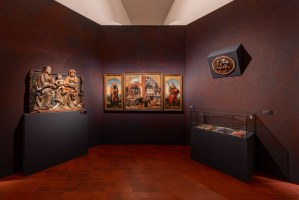
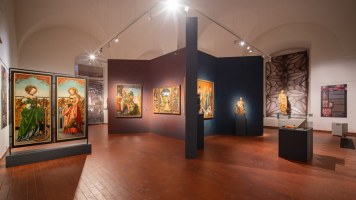
photo © Roman Dušek 2021
On the Czech side, the project's expert guarantor Jitka Šrejberová, on behalf of the Lead Partner, gave an introductory speech and further contributed with a presentation titled Transferregion Erzgebirge – Die Bedeutung Freibergs in der Kunstproduktion des böhmischen Erzgebirges und der Vorerzgebirgsregion.
In April 2021, the Ústí Region published five expert publications, contributed to by a team of experts and restorers involved in the project.
The publications serve as independent studies on five collection items restored from the property of the Ústí Region. The publications also set the stage for the presentation of scientific research results with a unified visual style under the title Cultural Heritage of the Ústí Region. The publications with the subtitle of the project were published in this order: Saint Anne Samotřetí (Volume 1), Votive Panel from Most by Master I.W. (Volume 2), Throne Madonna I. from the Most collection (Volume 3), Retable with St. Barbara from the Chomutov collection (Volume 4), and Madonna from Krupka II. (Volume 5). The publications are not for sale, and interested parties can borrow them from authorized libraries in the Ústí Region and libraries with the right of mandatory deposit, or in selected museum and specialized libraries. Furthermore, serious interested parties can pick them up at the Department of Culture and Heritage Protection of the Ústí Region Office. More details can be found in the link below.
The Czech side also participated in cooperation within the online colloquium organized by the German project partner in the project The Art of the Late Middle Ages in the Mining Region of the Ore Mountains, the Academy of Fine Arts in Dresden, on May 8, 2021.
Activities until January 2021
The Czech-German cross-border project The Art of the Late Middle Ages in the Mining Region of the Ore Mountains continues to successfully meet its milestones through the realization of individual activities. In the period from July 2020 to January 2021, project partners presented further results and outputs. The pandemic measures inspired the project to seek new ways to support culture and fulfill scientific research potential. At the same time, it was possible to achieve the goals of protecting and preserving the cultural heritage of the Ústí Region by restoring all five works.
By August 31, 2020, the restoration of the retable with St. Barbara from the Regional Museum in Chomutov (inv. no. O 996–1002, Plk 121) was completed, which was reinstalled by the restorer in its place on September 2, 2020.
The entire event was presented on the websites of both the museum and the Lead Partner – the Ústí Region, including its monthly magazine. The restoration of the retable was carried out by experienced restorer Mario Král (Brno), who had the first opportunity to carry out its complete restoration. The project here reaffirmed that it not only provided "broad opportunities for restorers from various corners of the Czech Republic to get involved and thus supported awareness of the cultural wealth of northwestern Bohemia," but also helped secure financially and technically demanding restoration of the cultural heritage of the Ústí Region.
By October 21, 2020, the project team realized the exhibition "The Story of Old Most: In Memory of Heide Mannlová," which was accompanied on the same day by a proceedings of the same name from the printer. Everything was based on the active and timely securing of necessary works, which relied on the artistic design of the exhibition and a firmly established structure of the proceedings. Details about both are below in the link. In parallel with them, preparations for the colloquium of the same name were underway for the opening date of the exhibition on October 22, 2020. However, due to pandemic measures, the colloquium was canceled and is planned to take place no later than June 30, 2021. The exhibition itself was opened on the scheduled date, but it could only be physically accessible to the public shortly before Christmas.
Even during the creation of the exhibition, the creative team, like others in the Czech Republic, had to deal with this eventuality, so a virtual tour was planned to be secured on the museum's website. The exhibition is thus permanently available to those interested in Old Most even after its conclusion. Thanks to the realized exhibition, it was possible to conserve and restore a number of collection items from the sub-collection of visual arts of the Regional Museum in Most, which formed the essence of the entire exhibition. Its concept thus had highly positive impacts on the care and protection of the collection. It is necessary to appreciate the dedicated and highly professional work of long-time museum conservator Dagmar Pícová. A selection of six appropriately chosen loans then helped, thanks to the kindness of the lenders, to illustrate the story of the vanished historical Most told by the museum collection.
Currently, the professional processing of all results into further defined outputs of the project is underway. One of the main upcoming events awaiting partners on the Czech side is the realization of the exhibition ORE MOUNTAINS / ERZGEBIRGE – THE ART OF THE LATE MIDDLE AGES from February 5 to April 18, 2021, at the Regional Museum in Chomutov, ancient town hall, 1st May Square 1, Chomutov, exhibition hall. Shortly thereafter, the exhibition will be accompanied by five expert publications summarizing the results of the team of all involved experts and restorers.
Activities until July 2020
The Czech-German cross-border project The Art of the Late Middle Ages in the Mining Region of the Ore Mountains has entered its second half in 2020 and is preparing for its conclusion in 2021. In 2020, the activities of project partners on the Czech side primarily included restoration, necessary material surveys, and scientific research, including its initial presentation within lecture activities. In August 2019, Asgard Kleinbauerová completed the restoration of the tondo with St. Anne Samotřetí from the decoration of the vault's keystone in the northern vestibule of the dean's church of the Assumption of the Virgin Mary in Most at the Hochschule für Bildende Künste in Dresden.
The tondo is one of the restored collection items in the project and has thus become a factual symbol of mutual cooperation between the Czech and German sides. The work is located in the collection of the Regional Museum and Gallery in Most (inv. no. UP 0393). On September 12, 2019, a retrospective workshop of the Ústí Region dedicated to the successful inscription of the site on the UNESCO World Heritage List, aptly titled "The Path of the Mining Region of the Ore Mountains/Erzgebirge to World Heritage (1998–2019)," took place at the Regional Museum and Gallery in Most (also OMGM) with financial support from the Ministry of Culture of the Czech Republic from the UNESCO Heritage Program. Here, the restored tondo was presented to the public for the first time, which will be showcased in 2021 along with other works in the final exhibition Ore Mountains/Erzgebirge. The Art of the Late Middle Ages.
By May 31, 2020, the restoration of three works was completed, both from the collection of the Regional Museum and Gallery in Most and from the collection of the Regional Museum in Teplice. The Votive Panel from Most by Master IW (OMGM inv. no. UOM 0368), Throne Madonna (OMGM inv. no. UP 0463), and Madonna from Krupka (Regional Museum in Teplice) returned to the museums after restoration. The transport was ensured by a professionally specialized company in early June 2020.
The restoration of the Votive Panel from Most was carried out by restorer Jakub Stretti (Prague). The Throne Madonna, also known from Litvínov, was restored by restorer Monika Wolfová (Kyjov). The Madonna from Krupka underwent the workshop of restorer Jindřich Šlechta (Horažďovice).
The project thus provided broad opportunities for restorers from various corners of the Czech Republic to get involved and supported awareness of the cultural wealth of northwestern Bohemia. The interdisciplinarity in the project and close cooperation during the restoration process was ensured by the Academic Laboratory for Material Research of Paintings (ALMA) at the Academy of Fine Arts in Prague. Currently, the professional processing of all results obtained during the restoration and material research process into predefined outputs of the project is underway. One of the important upcoming events awaiting partners on the Czech side in October 2020 is the organization of a professional colloquium and the exhibition The Story of Old Most with the subtitle In Memory of Heide Mannlová Raková. A proceedings of the same name will also be prepared for the professional colloquium.
Activities
In April 2019, as part of reciprocity, the Regional Museum and Gallery in Most loaned one of its collection items to the Regional Museum in Chomutov. This is the epitaph of Jindřich Piscator (inv. no. UOM 0477), transferred to the museum collections from the dean's church of the Assumption of the Virgin Mary in Most. The epitaph will replace the altar of St. Barbara, which is currently being restored, in the long-term exhibition of the Chomutov museum until 2021. The reciprocal loan of the epitaph of Jindřich Piscator († 1568–1569) allows for the re-exhibition of a work that has been hidden from visitors for a long time. At the same time, it is an opportunity to highlight the 450th anniversary of the death of this significant figure from Most. Not only the Latin inscription on the epitaph but also sources document that Jindřich Piscator enjoyed general recognition for his activities in the city. The inscription written in six lines states that "His virtues cannot fit on a small plate, / of which this city of Most is a witness." The plate thus serves as a reminder of his great influence on events in Most, where he was one of the main promoters of the Lutheran faith and served as a councilor and also as the mayor of Most (1566). In the case of the epitaph, it is a representative tombstone, and some researchers question whether it was already installed in the Most church at the time of its creation. Doubts arise primarily from the preserved data about disputes during burials in the church due to differing confessions. Despite these considerations, the epitaph belongs to the group of works from the decoration of the dean's church and reflects one of its important historical stages. It tells the story of a highly cultured city of the 16th century, whose social life centered around the city church, which was being built and lavishly equipped at that time. The painted epitaph tombstone captured the family of Jindřich Piscator, a father with three sons and a wife with a daughter. The entire scene, with its iconographic composition, traditionally refers to the salvation of man. Behind the family scene, two scenes are set in the landscape – the Baptism of Christ in the Jordan and unidentified figures of two men walking towards each other, while the central depiction culminates in the Throne of Grace, above which Christ is placed during the Last Judgment in the triangular gable structure.
The work is an example of "the artistic culture arising in the environment of Reformation churches in the territory of Bohemia," especially sepulchral art, where Lutheran culture has left an indelible mark despite the centuries. From an artistic perspective, its creator is classified within the circle close to the workshop of Lucas Cranach the Elder and Lucas Cranach the Younger. The general acceptance of this work and its reception are not unusual in this environment, especially since Lucas Cranach the Elder was not only a friend of Martin Luther but also of other religious reformers and humanists.
Prepared by Mgr. Jitka Šrejberová, Ph.D.
Selected Literature
HORNÍČKOVÁ, Kateřina, ŠRONĚK Michal (eds). The Art of the Czech Reformation (1380-1620). Prague 2010.
MANNLOVÁ, Heide, NOVÁKOVÁ, Zdenka. North Bohemian Art of the 14th–18th Century: A Guide to the Exhibition in the Relocated Gothic Church in Most. Ústí nad Labem, 1988.
MANNLOVÁ-RAKOVÁ, Heide. Cultural Monument Most: The Dean's Church and Its Builders. Prague 1988.
OTTOVÁ, Michaela, ROYT, Jan. The Church of the Assumption of the Virgin Mary in Most during the Confessional Changes (1517–1594). Ústí nad Labem 2014.
Research on the Mining Past of the Ore Mountains has received further support
The Regional Museum in Most will continue to support mutual Czech-German cooperation, which is developing on the platform of the shared mining past of the Ore Mountains region.
After several successfully implemented thematic projects from the cross-border cooperation program Goal 3/Ziel 3, the Monitoring Committee in Seiffen approved in September 2017 a project titled The Art of the Late Middle Ages in the Mining Region of the Ore Mountains, which will be implemented from 2018 to 2021 in the new Cooperation Program Czech Republic - Free State of Saxony SN-CZ 2014-2020.
The project involves the exchange of experiences and the development of cross-border cooperation through joint Czech-German activities in the form of research, rescue, and promotion of cultural heritage from the late medieval period. A significant role here is played by activities supporting the exchange of experiences among experts at the international level and the presentation of their work to the public. On the Czech side, five valuable artworks from sub-Ore Mountains museums will be examined and restored, while on the German side, comprehensive research on late Gothic altars in the Freiberg area will take place. The joint work will be presented to the public in the form of an exhibition and workshop.
Project partners include the Ústí Region, Hochschule für Bildende Künste Dresden, and the Regional Museum in Most, a contributory organization.
The project will be implemented under the measure Sustainable, Partnership Cooperation, priority axis Strengthening the Institutional Capacity of Public Authorities and Stakeholders and Contributing to Effective Public Administration.
The estimated total costs of the project amount to €1,141,000, of which €969,000 is supported by the European Union.
Cross-border conference on the 500th anniversary of the dean's church in Most
Lecture series - The Cathedral is 500 years old
Prepared by Mgr. Jitka Šrejberová, Ph.D.



